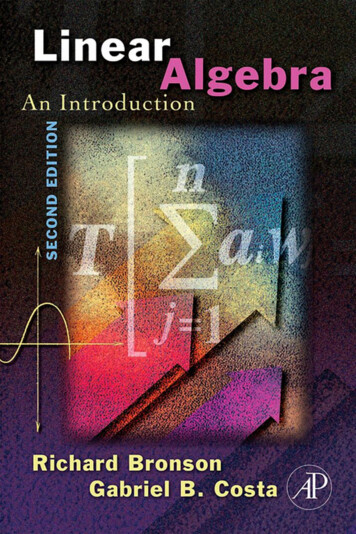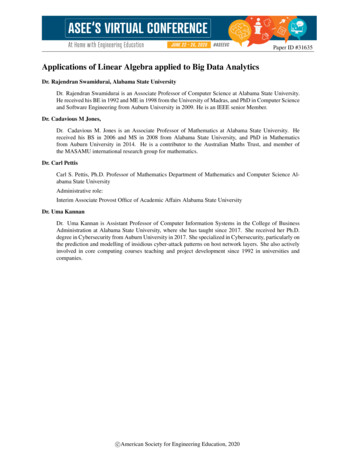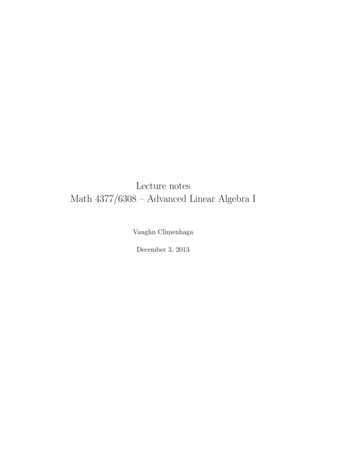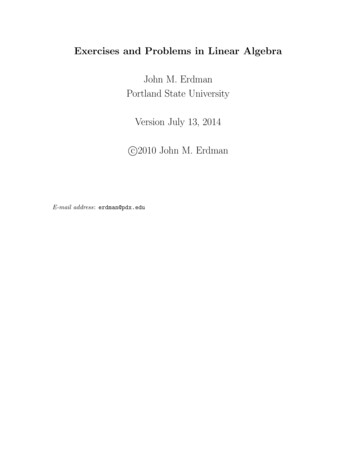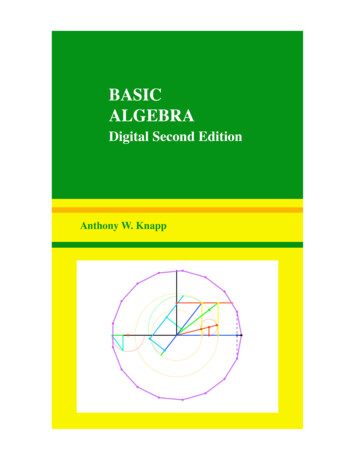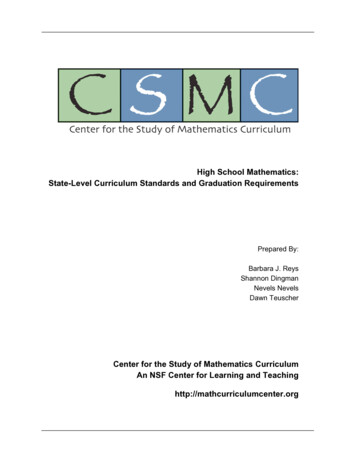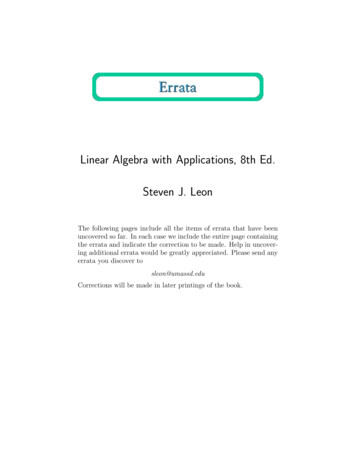
Transcription
Linear Algebra with Applications, 8th Ed.Steven J. LeonThe following pages include all the items of errata that have beenuncovered so far. In each case we include the entire page containingthe errata and indicate the correction to be made. Help in uncovering additional errata would be greatly appreciated. Please send anyerrata you discover tosleon@umassd.eduCorrections will be made in later printings of the book.
4Chapter 1 Matrices and Systems of EquationsTherefore, any solution of system (b) must also be a solution of system (a). By asimilar argument, it can be shown that any solution of (a) is also a solution of (b). Thiscan be done by subtracting the first equation from the second: 3x23x1 2x2 x3 2 3x1 x2 x3 5Then add the first and third equations:33x1 2x2 x3 22x3 43x1 2x2 x3 2Thus, (x1 , x2 , x3 ) is a solution of system (b) if and only if it is a solution of system (a).Therefore, both systems have the same solution set, {( 2, 3, 2)}.DefinitionTwo systems of equations involving the same variables are said to be equivalent ifthey have the same solution set.Clearly, if we interchange the order in which two equations of a system are written,this will have no effect on the solution set. The reordered system will be equivalent tothe original system. For example, the systemsx1 2x2 43x1 x2 24x1 x2 6and4x1 x2 63x1 x2 2x1 2x2 4both involve the same three equations and, consequently, they must have the samesolution set.If one equation of a system is multiplied through by a nonzero real number, thiswill have no effect on the solution set, and the new system will be equivalent to theoriginal system. For example, the systemsx1 x2 x3 3 2x1 x2 4x3 1and2x1 2x2 2x3 6 2x1 x2 4x3 1are equivalent.If a multiple of one equation is added to another equation, the new system willbe equivalent to the original system. This follows since the n-tuple (x1 , . . . , xn ) willsatisfy the two equationsai1 x1 · · · ain xn bia j1 x1 · · · a jn xn b jif and only if it satisfies the equationsai1 x1 · · · ain xn bi(a j1 αai1 )x1 · · · (a jn αain )xn b j αbiLeon:Linear Algebra with Applications 8/E 6/22/07 10:42 Page 4
8Chapter 1 Matrices and Systems of EquationsReturning to the example, we find that the first row is used to eliminate the elements in the first column of the remaining rows. We refer to the first row as the pivotalrow. For emphasis, the entries in the pivotal row are all in bold type and the entire rowis color shaded. The first nonzero entry in the pivotal row is called the pivot. (pivot a11 1) pivotal row1213 entries to be eliminated 3 1 3 1 a21 3 and a31 24231By using row operation III, 3 times the first row is subtracted from the second row and2 times the first row is subtracted from the third. When this is done, we end up withthe matrix 1213 pivotal row 0 7 6 10 0 1 1 2At this step we choose the second row as our new pivotal row and apply row operation III to eliminate the last element in the second column. This time, the pivot is 7 17 is the multiple of the pivotal row that is subtracted from theand the quotient 1 7third row. We end up with the matrix 1213 0 7 6 10 14 00 7 7This is the augmented matrix for the strictly triangular system, which is equivalent tothe original system. The solution of the system is easily obtained by back substitution.EXAMPLE 4 Solve the system4 x2x1 x22x1 4x23x1 x2 x3 x3 x3 2x3 x4 x4 2x4 2x4 0 6 1 3SolutionThe augmented matrix for this system is 0 1 110 11116 241 2 1 331 22Since it is not possible to eliminate any entries by using 0 as a pivot element, we willuse row operation I to interchange the first two rows of the augmented matrix. The newfirst row will be the pivotal row and the pivot element will be 1: pivot row(pivot a11 1) 11116 0 1 110 41 2 1 2331 22Leon:Linear Algebra with Applications 8/E 6/22/07 10:42 Page 8
1.2 Row Echelon Form8. Consider a linear system whose augmented matrixis of the form 1 1 224 2 1 2 313aFor what values of a will the system have a uniquesolution?9. Consider a linear system whose augmented matrixis of the form 1 2 125113β25x1 2x2 x3 1 x1 x2 2x3 22x1 3x2 2solve both systems by computing the row echelonform of an augmented matrix (A B) and performing back substitution twice.(b)13. Given a homogeneous system of linear equations,if the system is overdetermined, what are the possibilities as to the number of solutions? Explain.14. Given a nonhomogeneous system of linear equations, if the system is underdetermined, what arethe possibilities as to the number of solutions? Explain. 0 0 0(a) Is it possible for the system to be inconsistent?Explain.15. Determine the values of x1 , x2 , x3 , and x4 for thefollowing traffic flow diagram:(b) For what values of β will the system have infinitely many solutions?38010. Consider a linear system whose augmented matrixis of the form 1 1 112334a 2 3 bx4x1430x2(a) For what values of a and b will the system haveinfinitely many solutions?450420540400x3(b) For what values of a and b will the system beinconsistent?42011. Given the linear systemsx1 2x2 2(b) x1 2x2 13x1 7x2 83x1 7x2 7solve both systems by incorporating the right-handsides into a 2 2 matrix B and computing the reduced row echelon form of470(a) 1(A B) 32728 1 716. Consider the traffic flow diagram that follows,where a1 , a2 , a3 , a4 , b1 , b2 , b3 , b4 are fixed positiveintegers. Set up a linear system in the unknowns x1 ,x2 , x3 , x4 and show that the system will be consistent if and only if12. Given the linear systems(a)Leon:x1 2x2 x3 2 x1 x2 2x3 32x1 3x2 0a1 a2 a3 a4 b1 b2 b3 b4What can you conclude about the number of auto-Linear Algebra with Applications 8/E 6/22/07 10:42 Page 25
26Chapter 1 Matrices and Systems of Equationsmobiles entering and leaving the traffic network?a1b1b4a4x1these reactions are measured in moles (a standardunit of measurement for chemical reactions). Howmany moles of nitrogen, hydrogen, and oxygen arenecessary to produce 8 moles of nitric acid?21. In Application 4, determine the relative values ofx1 , x2 , and x3 if the distribution of goods is as described in the following table:Fx4x2Ma2b2Cb3x3a3FMC13131313121613161222. Determine the amount of each current for the following networks:(a)16 voltsi117. Let (c1 , c2 ) be a solution of the 2 2 system2 ohmsa11 x1 a12 x2 0a21 x1 a22 x2 0Show that, for any real number α, the ordered pair(αc1 , αc2 ) is also a solution.18. In Application 3, the solution (6, 6, 6, 1) was obtained by setting the free variable x4 1.(a) Determine the solution corresponding to x4 0. What information, if any, does this solutiongive about the chemical reaction? Is the term“trivial solution” appropriate in this case?(b) Choose some other values of x4 , such as 2, 4, or5, and determine the corresponding solutions.How are these nontrivial solutions related?19. Liquid benzene burns in the atmosphere. If a coldobject is placed directly over the benzene, waterwill condense on the object and a deposit of soot(carbon) will also form on the object. The chemical equation for this reaction is of the formA(b)i22 ohmsi33 ohms2 ohmsA(c)Bi1i220 volts 4 ohmsi32 ohmsB8 voltsi1x1 C6 H6 x2 O2 x3 C x4 H2 ODetermine values of x1 , x2 , x3 , and x4 to balancethe equation.20. Nitric acid is prepared commercially by a series ofthree chemical reactions. In the first reaction, nitrogen (N2 ) is combined with hydrogen (H2 ) to formammonia (NH3 ). Next, the ammonia is combinedwith oxygen (O2 ) to form nitrogen dioxide (NO2 )and water. Finally, the NO2 reacts with some of thewater to form nitric acid (HNO3 ) and nitric oxide(NO). The amounts of each of the components ofLeon:4 ohms2 ohmsAi2i3CLinear Algebra with Applications 8/E 6/22/07 10:42 Page 26Bi44 ohms i5D5 ohms10 voltsi6
1.4 Matrix Algebra49If we let ei denote the average number of eggs laid by a member of stage i (i 2, 3, 4)in 1 year and form the matrix p1 e2 e3 e4 q 1 p2 0 0 (3)L p00q 23 0 0 q 3 p4then L can be used to predict the turtle populations at each stage in future years. Amatrix of the form (3) is called a Leslie matrix, and the corresponding populationmodel is sometimes referred to as a Leslie population model. Using the figures fromTable 1, the Leslie matrix for our model is 0012779 00 0.67 0.7394 L 00.000600 000.81 0.8077Suppose that the initial populations at each stage were 200,000, 300,000, 500,and 1500, respectively. If we represent these initial populations by a vector x0 , thepopulations at each stage after 1 year are determined with the matrix equation 0012779 200,000 182,000 00 0.67 0.7394 300,000 355,820 x1 Lx0 00.000600500180 000.81 0.80771,5001,617(The computations have been rounded to the nearest integer.) To determine the population vector after 2 years, we multiply again by the matrix L:x2 Lx1 L 2 x0In general, the population after k years is determined by computing xk L k x0 . Tosee longer range trends, we compute x10 , x25 , and x50 . The results are summarized inTable 2. The model predicts that the total number of breeding-age turtles will decreaseby 80 percent over a 50-year period.Table 2 Loggerhead Sea Turtle Population 2141,06174,039213,66913968735,966103,79568334A seven-stage model describing the population dynamics is presented in reference [1] to follow. We will use the seven-stage model in the computer exercises at theend of this chapter. Reference [2] is the original paper by Leslie.Leon:Linear Algebra with Applications 8/E 6/22/07 10:42 Page 49
54Chapter 1 Matrices and Systems of EquationsSymmetric Matrices and NetworksRecall that a matrix A is symmetric if A T A. One type of application that leads tosymmetric matrices is problems involving networks. These problems are often solvedwith the techniques of an area of mathematics called graph theory.APPLICATION 3Networks and GraphsGraph theory is an important areas of applied mathematics. It is used to model problems in virtually all the applied sciences. Graph theory is particularly useful in applications involving communication networks.A graph is defined to be a set of points called vertices, together with a set ofunordered pairs of vertices, which are referred to as edges. Figure 1.4.2 gives a geometrical representation of a graph. We can think of the vertices V1 , V2 , V3 , V4 , and V5as corresponding to the nodes in a communication network.V1V2V3V5V4Figure 1.4.2.The line segments joining the vertices correspond to the edges:{V1 , V2 }, {V2 , V5 }, {V3 , V4 }, {V3 , V5 }, {V4 , V5 }Each edge represents a direct communication link between two nodes of the network.An actual communication network could involve a large number of vertices andedges. Indeed, if there are millions of vertices, a graphical picture of the network wouldbe quite confusing. An alternative is to use a matrix representation for the network. Ifthe graph contains a total of n vertices, we can define an n n matrix A by 1 if {Vi , V j } is an edge of the graphai j 0 if there is no edge joining Vi and V jThe matrix A is called the adjacency matrix of the graph. The adjacency matrix for thegraph in Figure 1.4.2 is given by 0 1 0A 00Leon:100010001100101Linear Algebra with Applications 8/E 6/22/07 10:42 Page 54 0 1 1 1 0
1.5 Elementary Matrices 1 2(g) 3 368 3 1 1 1(h) 3 101 2 1 1 311. Given 3A 5 1 2and 1B 3 2 4compute A 1 and use it to(a) find a 2 2 matrix X such that AX B.(b) find a 2 2 matrix Y such that Y A B. 3 , B 622 2 ,C 44 6where a0 , a1 , . . . , ak are scalars, thenAB B A. 2 3Solve each of the following matrix equations:(b) XA B C(a) AX B C(d) XA C X(c) AX B X13. Is the transpose of an elementary matrix an elementary matrix of the same type? Is the product of twoelementary matrices an elementary matrix?14. Let U and R be n n upper triangular matrices andset T UR. Show that T is also upper triangularand that t j j u j j r j j for j 1, . . . , n.15. Let A be a 3 3 matrix and suppose that2a1 a2 4a3 0How many solutions will the system Ax 0 have?Explain. Is A nonsingular? Explain.16. Let A be a 3 3 matrix and suppose thata1 3a2 2a3Will the system Ax 0 have a nontrivial solution?Is A nonsingular? Explain your answers.17. Let A and B be n n matrices and let C A B.Show that if Ax0 Bx0 and x0 0, then C mustbe singular.22. Show that if A is a symmetric nonsingular matrix,then A 1 is also symmetric.23. Prove that if A is row equivalent to B, then B isrow equivalent to A.24. (a) Prove that if A is row equivalent to B and B isrow equivalent to C, then A is row equivalentto C.(b) Prove that any two nonsingular n n matricesare row equivalent.25. Let A and B be m n matrices. Prove that if B isrow equivalent to A and U is any row echelon formA, then B is row equivalent to U .26. Prove that B is row equivalent to A if and onlyif there exists a nonsingular matrix M such thatB MA.27. Is it possible for a singular matrix B to be rowequivalent to a nonsingular matrix A? Explain.28. Given a vector x Rn 1 , the (n 1) (n 1)matrix V defined by 1if j 1vi j j 1for j 2, . . . , n 1xiis called the Vandermonde matrix.(a) Show that ifVc y18. Let A and B be n n matrices and let C AB.Prove that if B is singular, then C must be singular.[Hint: Use Theorem 1.5.2.]and19. Let U be an n n upper triangular matrix withnonzero diagonal entries.(a) Explain why U must be nonsingular.(b) Explain why U 1 must be upper triangular.then20. Let A be a nonsingular n n matrix and let B be ann r matrix. Show that the reduced row echelonform of (A B) is (I C), where C A 1 B.Leon:21. In general, matrix multiplication is not commutative (i.e., AB B A). However, in certain specialcases the commutative property does hold. Showthat(a) if D1 and D2 are n n diagonal matrices, thenD1 D 2 D 2 D 1 .(b) if A is an n n matrix andB a0 I a1 A a2 A 2 · · · ak A k12. Let 5A 367p(x) c1 c2 x · · · cn 1 x np(xi ) yi ,i 1, 2, . . . , n 1(b) Suppose that x1 , x2 , . . . , xn 1 are all distinct.Show that if c is a solution to V x 0, then thecoefficients c1 , c2 , . . . , cn must all be zero andhence V must be nonsingular.Linear Algebra with Applications 8/E 7/15/07 19:13 Page 67of
82thenChapter 1 Matrices and Systems of Equations 4AB 7 5 10and 11BA 4 7 3This proves thatreducedstatement (ii) is false.1. If the row echelon form of A involves free variables, then the system Ax b will have infinitelymany solutions.2. Every homogeneous linear system is consistent.3. An n n matrix A is nonsingular if and only if thereduced row echelon form of A is I (the identitymatrix).4. If A is nonsingular, then A can be factored into aproduct of elementary matrices.5. If A and B are nonsingular n n matrices, thenA B is also nonsingular and(A B) 1 A 1 B 1 .6. If A A 1 , then A must be equal to either I or I .7. If A and B are n n matrices, then(A B)2 A2 2AB B 2 .8. If AB AC and A O (the zero matrix), thenB C.9. If AB O, then B A O.10. If A is a 3 3 matrix and a1 2a2 a3 0, thenA must be singular.11. If A is a 4 3 matrix and b a1 a3 , then thesystem Ax b must be consistent.12. Let A be a 4 3 matrix with a2 a3 . If b a1 a2 a3 , then the system Ax b will haveinfinitely many solutions.13. If E is an elementary matrix, then E T is also anelementary matrix.14. The product of two elementary matrices is an elementary matrix.15. If x and y are nonzero vectors in Rn and A xyT ,then the row echelon form of A will have exactlyone nonzero row.CHAPTER TEST B1. Find all solutions of the linear systemx1 x2 3x3 2x4 1 x1 x2 2x3 x4 22x1 2x2 7x3 7x4 12. (a) A linear equation in two unknowns corresponds to a line in the plane. Give a similargeometric interpretation of a linear equation inthree unknowns.(b) Given a linear system consisting of two equations in three unknowns, what is the possiblenumber of solutions? Give a geometric explanation of your answer.(c) Given a homogeneous linear system consistingof two equations in three unknowns, how manysolutions will it have? Explain.3. Let Ax b be a system of n linear equations inn unknowns, and suppose that x1 and x2 are bothsolutions and x1 x2 .(a) How many solutions will the system have? Explain.(b) Is the matrix A nonsingular? Explain.4. Let A be a matrix of the form β αA 2α 2βLeon:where α and β are fixed scalars not both equal to 0.(a) Explain why the system 3 Ax 1must be inconsistent.(b) How can one choose a nonzero vector b so thatthe system Ax b will be consistent? Explain.5. Let 2 1 3 2 1 3 1 3 5 4 2 7 A B 4 2 71 3 5 0 1 3 0 2 7 C 5 3 5(a) Find an elementary matrix E such thatE A B.(b) Find an elementary matrix F such thatAF C.6. Let A be a 3 3 matrix and letb 3a1 a2 4a3Will the system Ax b be consistent? Explain.Linear Algebra with Applications 8/E 6/22/07 10:42 Page 82
152Chapter 3 Vector Spacesthe transition matrix from [1, 2x, 4x 2 2] to [1, x, x 2 ]. Since1 1 · 1 0x 0x 22x 0 · 1 2x 0x 24x 2 2 2 · 1 0x 4x 2 1 0S 0the transition matrix is 0 2 20 04The inverse of S will be the transition matrix from [1, x, x 2 ] to [1, 2x, 4x 2 2]: 1 0 12 1 S 1 00 2 1 0 0 4Given any p(x) a bx cx 2 in P3 , to find the coordinates of p(x) with respect to[1, 2x, 4x 2 2], we simply multiply 1 10c 2 a 11 b 0 2 0 b 2 c 1 1 c0 0 44Thus,p(x) (a 12 c) · 1 ( 12 b) · 2x 14 c · (4x 2 2)We have seen that each transition matrix is nonsingular. Actually, any nonsingularmatrix can be thought of as a transition matrix. If S is an n n nonsingular matrix and{v1 , . . . , vn } is an ordered basis for V , then define {w1 , w2 , . . . , wn } by (4). To see thatthe w j ’s are linearly independent, suppose thatn xjwj 0j 1It follows from (4) that nn i 1 si j x j v j 0j 1By the linear independence of the vi ’s, it follows thatn si j x j 0i 1, . . . , nj 1or, equivalently,Leon:Sx 0Linear Algebra with Applications 8/E 6/26/07 07:54 Page 43
248Chapter 5 OrthogonalityTheorem 5.5.7Let S be a subspace of an inner product space V and let x V . Let {u1 , u2 , . . . , un }be an orthonormal basis for S. Ifnp ci ui(3)i 1whereci x, ui for each i(4)then p x S (see Figure 5.5.2).xp–xSpFigure 5.5.2.ProofWe will show first that (p x) ui for each i: ui , p x ui , p ui , x n xi ,c j u j cij 1n c j ui , u j cij 1 0So p x is orthogonal to all the ui ’s. If y S, thennαi uiy i 1and hencennαi ui p x, y p x,i 1αi p x, ui 0i 1If x S, the preceding result is trivial, since, by Theorem 5.5.2, p x 0. Ifx S, then p is the element in S closest to x.Theorem 5.5.8Under the hypothesis of Theorem 5.5.7, p is the element of S that is closest to x; thatis, y x p x for any y p in S.Leon:Linear Algebra with Applications 8/E 7/15/07 14:34 Page 51
6.4 Hermitian Matrices2. Let 1 i 2z1 1 i 2 and i 2 z2 1 2(a) Show that {z1 , z2 } is an orthonormal set in C2 . as a linear 2 4i (b) Write the vector z 2icombination of z1 and z2 .3. Let {u1 , u2 } be an orthonormal basis for C2 , and letz (4 2i)u1 (6 5i)u2 .(a) What are the values of u1H z, z H u1 , u2H z, andz H u2 ?(b) Determine the value of z .4. Which of the matrices that follow are Hermitian?Normal? 2 i 1 1 i 2 (b) (a) 2 i 123 11 2 2 (c) 11 22 11 i 22 (d) 11 i 22 i1 0 0 2 i (e) i 1 2 i0 31 i i 1 i13 (f) i315. Find an orthogonal or unitary diagonalizing matrixfor each of the following: 13 i 2 1 (b)(a)3 i41 2 11 2 2 i 0 13 2 i 2 0 (d) (c) 1 230 0 2 0 0 1 1 1 1 1 1 1 0 1 0 (f) (e) 1 1 11 0 0 2 2 4 21 1 (g) 2 11Leon:3356. Show that the diagonal entries of a Hermitian matrix must be real.7. Let A be a Hermitian matrix and let x be a vectorin Cn . Show that if c xAx H , then c is real.8. Let A be a Hermitian matrix and let B i A. Showthat B is skew Hermitian.9. Let A and C be matrices in Cm n and let B Cn r .Prove each of the following rules:(a) (A H ) H A(b) (α A βC) H α A H βC H(c) (AB) H B HA H10. Let A and B be Hermitian matrices. Answer trueor false for each of the statements that follow. Ineach case, explain or prove your answer.(a) The eigenvalues of AB are all real.(b) The eigenvalues of AB A are all real.11. Show thatz, w w H zdefines an inner product on Cn .12. Let x, y, and z be vectors in Cn and let α and β becomplex scalars. Show thatz, αx βy α z, x β z, y 13. Let {u1 , . . . , un } be an orthonormal basis for a complex inner product space V , and letz a1 u1 a2 u2 · · · an unw b1 u1 b2 u2 · · · bn unShow thatnz, w bi aii 114. Given that15.16.17.18. 4 0A 001 i 0 i 1find a matrix B such that B H B A.Let U be a unitary matrix. Prove that(a) U is normal.(b) U x x for all x Cn .(c) if λ is an eigenvalue of U , then λ 1.Let u be a unit vector in Cn and define U I 2uu H . Show that U is both unitary and Hermitian and, consequently, is its own inverse.Show that if a matrix U is both unitary and Hermitian, then any eigenvalue of U must equal either 1or 1.Let A be a 2 2 matrix with Schur decompositionU T U H and suppose that t12 0. Show thatLinear Algebra with Applications 8/E 7/15/07 15:02 Page 54
318Chapter 6 Eigenvaluescolor-blind men is p and, over a number of generations, no outsiders have entered thepopulation, there is justification for assuming that the proportion of genes for colorblindness in the female population is also p. Since color blindness is recessive, wewould expect the proportion of color-blind women to be about p 2 . Thus, if 1 percentof the male population is color blind, we would expect about 0.01 percent of the femalepopulation to be color blind.The Exponential of a MatrixGiven a scalar a, the exponential ea can be expressed in terms of a power seriesea 1 a 1 21a a3 · · ·2!3!Similarly, for any n n matrix A, we can define the matrix exponential e A in terms ofthe convergent power series1 21A A3 · · ·(6)2!3!The matrix exponential (6) occurs in a wide variety of applications. In the case of adiagonal matrix λ1 λ2 D . . . λnthe matrix exponential is easy to compute: 1 m1 2De lim I D D · · · Dm 2!m! m 1 λ k λ1 e 1 k! λ2k 1 e . . lim . . . m . m 1 λn k e λ k! n k 1eA I A It is more difficult to compute the matrix exponential for a general n n matrix A. If,however, A is diagonalizable, thenfor k 1, 2, . . .Ak XD k X 1 11e A X I D D 2 D 3 · · · X 12!3! X e D X 1EXAMPLE 6 Compute e A forLeon: 2 6 A 13Linear Algebra with Applications 8/E 7/15/07 15:02 Page 37
6.5 The Singular Value DecompositionthenProof2 A A F σk 1 · · · σn2 1/2343 min A S FS MLet X be a matrix in M satisfying (7). Since A M, it follows that2 · · · σn2 A X F A A F σk 1We will show that2 A X F σk 1 · · · σn2 1/2(8) 1/2and hence that equality holds in (8). Let Q P T be the singular value decompositionof X , where ω1 ω2 O k . . .O O O ωk OOIf we set B Q T A P, then A Q P T , and it follows that A X F Q(B )P T F B Let us partition B in the same manner as B : k kk (n k)B11B12B21 B22 (m k) k F (m k) (n k)It follows that A X 2F B11 2k F B12 2F B21 2F B22 2FWe claim that B12 O. If not, then define B11Y Q O B12 PTOThe matrix Y is in M and A Y 2F B21 2F B22 2F A X 2FBut this contradicts the definition of X . Therefore, B12 O. In a similar manner, itcan be shown that B21 must equal O. If we set B11 O PTZ QO OLeon:Linear Algebra with Applications 8/E 7/15/07 15:02 Page 62
6.6 Quadratic Formsyyyx(i) Circley(iii) Hyperbola(ii) Ellipsexxx353(iv) ParabolaFigure 6.6.1.Case 3. The conic section has been rotated from the standard position by an angle θthat is not a multiple of 90. This occurs when the coefficient of the x y term is nonzero(i.e., b 0).In general, we may have any one or any combination of these three cases. To grapha conic section that is not in standard position, we usually find a new set of axes x andy such that the conic section is in standard position with respect to the new axes. Thisis not difficult if the conic has only been translated horizontally or vertically, in whichcase the new axes can be found by completing the squares. The following exampleillustrates how this is done:EXAMPLE 1 Sketch the graph of the equation9x 2 18x 4y 2 16y 11 0SolutionTo see how to choose our new axis system, we complete the squares:9(x 2 2x 1) 4(y 2 4y 4) 11 9 16This equation can be simplified to the form(y 2)2(x 1)2 12232If we letx x 1andthe equation becomesy y 2(x )2(y )2 12232which is in standard form with respect to the variables x and y . Thus, the graph, asshown in Figure 6.6.2, will be an ellipse that is in standard position in the x y -axissystem. The center of the ellipse will be at the origin of the x y -plane [i.e., at the point(x, y) (1, 2)]. The equation of the x -axis is simply y 0, which is the equationof the line y 2 in the x y-plane. Similarly, the y -axis coincides with the line x 1.Leon:Linear Algebra with Applications 8/E 7/15/07 15:02 Page 72
7.4 Matrix Norms and Condition Numbers11. Let A wyT , where w Rm and y Rn . ShowthatAx 2 y 2 w 2 for all x 0 in Rn .(a)x 2(b)12. LetA2 y2w2 3 1A 4(a) Determine A .(b) Find a vector x whose coordinates are each 1 such that Ax A . (Note thatx 1, so A Ax / x .)13. Theorem 7.4.2 states that nA max1 i m ai j j 1Prove this in two steps.(a) Show first thatnA max1 i m ai j j 1(b) Construct a vector x whose coordinates areeach 1 such that nAx Ax max ai j 1 i mx j 114. Show that A F A T F .15. Let A be a symmetric n n matrix. Show thatA A 1.16. Let A be a 5 4 matrix with singular values σ1 5, σ2 3, and σ3 σ4 1. Determine the valuesof A 2 and A F .17. Let A be an m n matrix.(a) Show that A 2 A F .(b) Under what circumstances will A 2 A F ?18. Let · denote the family of vector norms and let· M be a subordinate matrix norm. Show thatAM max Axx 119. Let A be an m n matrix and let · v and · wbe vector norms on Rn and Rm , respectively. ShowthatAx wA v,w maxx 0x vm ndefines a matrix norm on R .Leon:20. Let A be an m n matrix. The 1,2-norm of A isgiven byAx 2A 1,2 maxx 0x 1(See Exercise 19.) Show thatA 2 7 4 1214151,2 max ( a1 2 , a2 2 , . . . , an 2 )21. Let A be an m n matrix. Show thatA 1,2 A 222. Let A be an m n matrix and let B Rn r . Showthat(a) Ax A 1,2 x 1 for all x in Rn .(b) AB 1,2 A 2 B 1,223. Let A be an n n matrix and let · M be a matrix norm that is compatible with some vector normon Rn . Show that if λ is an eigenvalue of A, then λ A M .24. Use the result from Exercise 23 to show that if λ isan eigenvalue of a stochastic matrix, then λ 1.25. Sudoku is a popular puzzle involving matrices. Inthis puzzle, one is given some of the entries of a9 9 matrix A and asked to fill in the missing entries. The matrix A has block structure A11 A12 A13 A21 A22 A23 A A31 A32 A33where each submatrix Ai j is 3 3. The rules of thepuzzle are that each row, each column, and each ofthe submatrices of A must be made up of all of theintegers 1 through 9. We will refer to such a matrixas a sudoku matrix. Show that if A is a sudokumatrix, then λ 45 is its dominant eigenvalue.26. Let Ai j be a submatrix of a sudoku matrix A (seeExercise 25). Show that if λ is an eigenvalue of Ai j ,then λ 22.27. Let A be an n n matrix and x Rn . Prove:(a) Ax n 1/2 A 2 x (b) Ax 2 n 1/2 A x 2(c) n 1/2 A 2 A n 1/2 A 228. Let A be a symmetric n n matrix with eigenvalues λ1 , . . . , λn and orthonormal eigenvectorsu1 , . . . , un . Let x Rn and let ci uiT x fori 1, 2, . . . , n. Show thatn(a)Ax22 (λi ci )2i 1(b) If x 0, thenLinear Algebra with Applications 8/E 7/15/07 16:25 Page 30min λi 1 i nAx 2 max λi 1 i nx 2
474Answers to Selected Exercises5. (a) det(A) 0, so A is singular. 12 1 2 42 and(b) adj A 12 1 0 0 0 0 0 0 A adj A 0 0 09. (a) det(adj(A)) 8 and det(A) 2 1000 4 11 0 (b) A 0 62 2 010114. D O YOUR H OMEWORK .3.3CHAPTER TEST A1. True 2. False 3. False 4. True 5. False6. True 7. True 8. True 9. False 10. TrueChapter 33.1 1. (a) x1 10, x2 17(b) x3 13 x1 x2 2. (a) x1 5, x2 3 5 (b) x3 4 5 x1 x2 7. If x y x for all x in the vector space, then0 0 y y.8. If x y x z, then3.4 x (x y) x (x z)11.3.21.2.3.4.5.6.11.12.16.Leon:and the conclusion follows from axioms 1, 2,3, and 4.V is not a vector space. Axiom 6 does nothold.(a) and (c) are subspaces; (b), (d), and (e) arenot.(b) and (c) are subspaces; (a) and (d) are not.(a), (c), (e), and (f) are subspaces; (b), (d),and (g) are not.(a) {(0, 0)T }(b) Span(( 2, 1
Linear Algebra with Applications, 8th Ed. Steven J. Leon The following pages include all the items of errata that have been uncovered so far. In each case we include the entire page containing the errata and indicate the correction to be made. Help in uncover-ing additional errata would be gr
